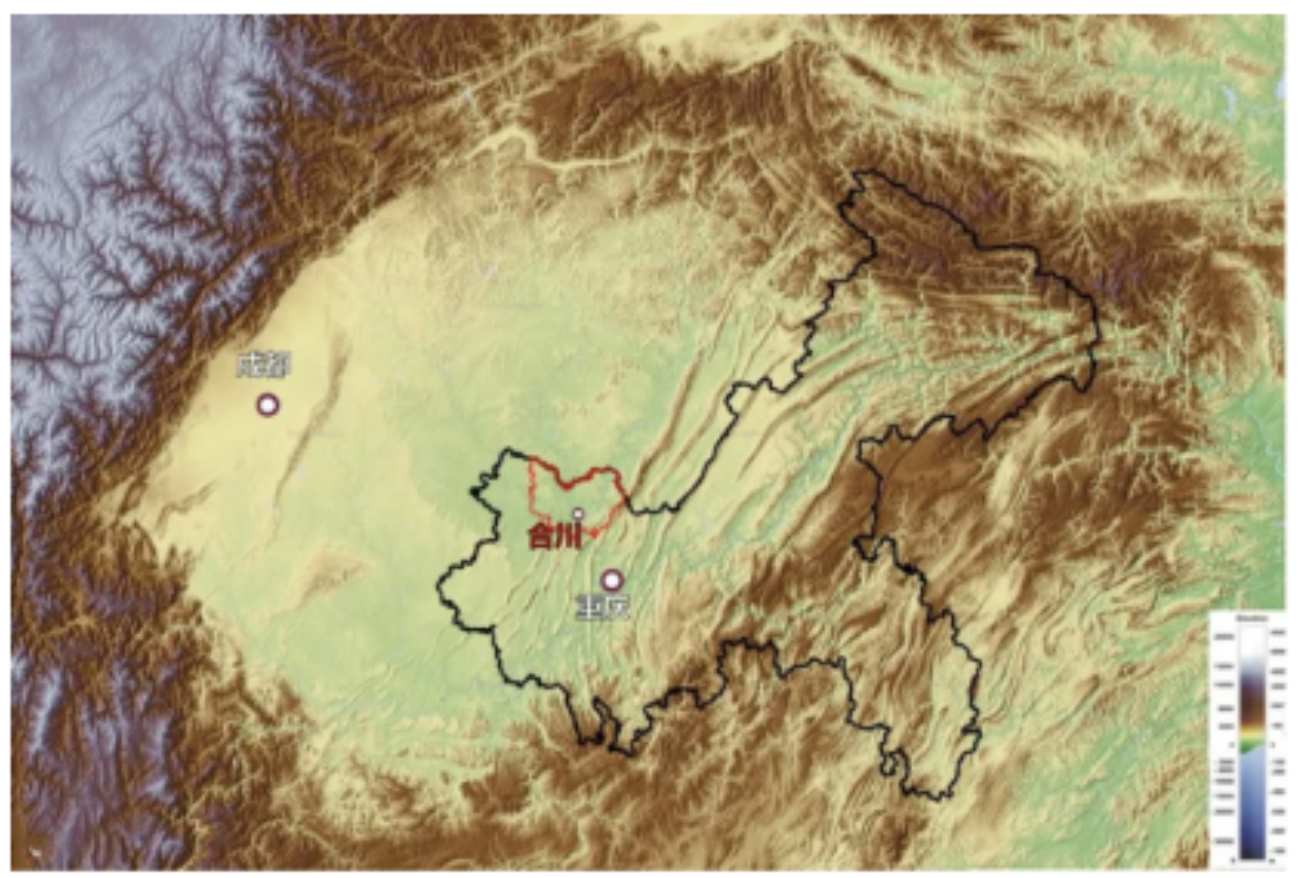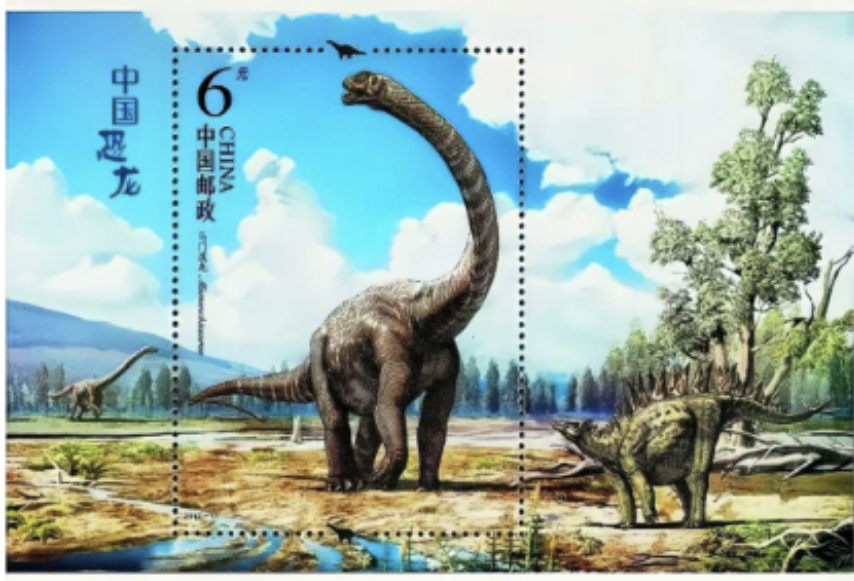



Yidu Hechuan: A Brilliant Pearl on the Three Rivers.
Mamenchisaurus: Hechuan in the Geological Age
Today's Hechuan is located in the upper reaches of the Yangtze River region, at the junction of the hinterland of the Sichuan Basin and the parallel valleys in eastern Sichuan. It is in the core area of the Chengdu-Chongqing Dual-City Economic Circle and an important strategic fulcrum city in the main urban area of Chongqing. The whole district covers an area of 2,344 square kilometers with a permanent population of 1.25 million. It is a major transportation artery connecting Chongqing with Shaanxi, Gansu and other places, as well as a transportation hub in the northwest of Chongqing and the northeast of Sichuan.
The beginning of the Hechuan region can be traced back to the distant dinosaur era - the Jurassic in geological archaeology. During this period, reptiles were very prosperous, with the emergence of huge dinosaurs, flying dragons in the air, and Archaeopteryx. Among plants, cycads and ginkgoes were the most flourishing. Dinosaurs, as terrestrial reptiles, suddenly disappeared completely 65 million years ago in the Cretaceous period, becoming a mystery in the history of Earth's biological evolution, a mystery that no one has been able to solve so far.

▲ Remote Sensing Image Map of Sichuan Basin
Drawn by Mo Xuanyan
Hechuan is the hometown of dinosaurs. From the fossils of Mamenchisaurus discovered in Gulou Mountain, Taihe Township, Hechuan in April 1957, it can be inferred that: it was of large size, with a total length of 22 meters, a height of 3.5 meters, and a weight ranging from 40 to 50 tons. This was not only the largest dinosaur in Asia but also one of the largest dinosaurs in the world.
The most prominent feature of Mamenchisaurus was that it had the longest neck in the world. If it were compared with a giraffe, the giraffe would be completely outmatched. Its neck was as long as 10 meters, three times that of a giraffe, thus earning it the reputation of "Oriental Giant Dragon".
Mamenchisaurus was a herbivorous dinosaur that lived 140 million years ago. In this way, the mysterious veil of the earliest regional climate in Hechuan was lifted, and Mamenchisaurus thus became a witness to the beginning of the Hechuan region.

▲ Body Shape Diagram of Mamenchisaurus from Hechuan
At this time, the Hechuan region was located in the lakeside area of the ancient Bashu Lake, with many swamps around, a hot climate, and abundant water and grass. It was covered with vast forests, where redwood and sequoia trees grew everywhere. Groups of Mamenchisaurus roamed among them, using their small, nail-like teeth to nibble on leaves and the tender branches at the top of trees that other dinosaurs couldn't reach, being carefree and clumsily hopping around.
According to experts' inference, the Mamenchisaurus in Hechuan had to eat two hundred kilograms of food every day. It kept eating and growing throughout its life, which led to such a huge body size.
Regarding the formation of the ancient Bashu Lake, it mainly originated from the intense crustal movement - the "Indosinian Movement" that occurred more than 200 million years ago. This movement caused the edge of the basin to gradually rise into mountains, and the Sichuan platform as a whole was uplifted. The edge of the basin was enclosed, and the areas submerged by seawater gradually rose to form land, transforming from a sea basin to a lake basin. At that time, the lake water almost occupied the entire present Sichuan Basin and was called Bashu Lake. Approximately two to three million years ago, the Yangtze River finally cut through the Wushan Mountains, forming the famous Three Gorges of the Yangtze River. The water in the basin was incorporated into the Yangtze River, and the Sichuan Basin changed from an inland basin to an outflow basin.

▲ Excavation Site of Mamenchisaurus Fossils in Hechuan
Regarding the origin of the name "Hechuan Mamenchisaurus", it can be traced back to 1952. That year, when workers were building a highway near the Mamingxi Ferry on the Jinsha River, they discovered many bone-like stones. Later, after careful research by Professor Yang Zhongjian, a renowned paleontologist from the Chinese Academy of Sciences, he believed that this was a new type of dinosaur fossil that had not been discovered in the world before, so he named it "Mamingxisaurus". Professor Yang was from Shaanxi. After the naming, other researchers, due to Professor Yang's accent, mistakenly heard "Mamingxi" as "Mamenxi". Since then, Mamenxisaurus has been recorded in various literatures. After the Hechuan dinosaur fossils were unearthed, Professor Yang Zhongjian determined its species and officially named it "Hechuan Mamenchisaurus". As a significant scientific discovery, it attracted the attention of Guo Moruo, who was then the president of the Chinese Academy of Sciences. He also wrote the calligraphy title "Hechuan Mamenchisaurus" with great interest.
The discovery and research of Hechuan Mamenchisaurus is a milestone in the world's dinosaur research.

▲ Inscription by Guo Moruo for Mamenchisaurus in Hechuan in 1965
In 1972, the book "Hechuan Mamenchisaurus" was published, attracting worldwide attention and marking that China's dinosaur research had reached the forefront of the world.
In the 1980s, when the United Arab Emirates was building its national museum, it was willing to offer a huge sum of 30 million US dollars to collect the fossils of Hechuan Mamenchisaurus as the treasure of the museum, which fully demonstrated its influence worldwide.
In the 10th issue of the magazine "Global Science" in 2009, the 60 outstanding achievements made by Chinese scientists since 1949 were announced. The discovery of Hechuan Mamenchisaurus was selected and ranked 5th.
So far, Hechuan Mamenchisaurus remains the most internationally renowned dinosaur fossil in China. As a prototype, Hechuan Mamenchisaurus has made a cameo appearance in the Hollywood classic series of blockbusters "Jurassic Park" and "Jurassic World". The Apatosaurus in the movies is its on-screen image.
As a commemoration, in 2017, Hechuan Mamenchisaurus was undoubtedly selected for the "Chinese Dinosaurs" special stamps due to its rarity and uniqueness, making a brilliant appearance on the "national business card".
As the "dinosaur envoy", Hechuan Mamenchisaurus - the top stream among dinosaurs, its fossils have also been exhibited abroad many times, opening a window for the world to understand and recognize the ancient biological world.

▲ Mamenchisaurus from Hechuan was selected for the Special Stamps of "Chinese Dinosaurs"
Since the first discovery of dinosaur fossils in Taihe Town by the Fujiang River in 1957, Hechuan has again discovered dinosaur fossils in Dashi Town by the Jialing River in 2015 and in Guandu Town by the Qujiang River in 2021 respectively. The distances between the three places are no more than 18 - 38 kilometers, and they are all from the same era, belonging to the Mamenchisaurus fauna stage. The discovery of these fossils has further enhanced the popularity and reputation of Hechuan as the hometown of dinosaurs. Hechuan is a city built on the back of dinosaurs. The place where we are living now was once the "Jurassic Park".
The Hechuan Mamenchisaurus, a precious and rare dinosaur fossil in Bashu, should be collected by whom? Museums in Beijing Natural History Museum, Institute of Vertebrate Paleontology and Paleoanthropology of Chinese Academy of Sciences, and even in Shanghai, Tianjin and other places have all been eager to try. Eventually, after a journey from Chongqing to Chengdu, to Beijing, and then back to Chengdu, it officially "settled down" in Chengdu College of Geology (now Chengdu University of Technology). Have you ever visited it? The Gulou Mountain in Taihe Town, Hechuan - the excavation site of Mamenchisaurus, have you ever paid a visit to it?
We have only imagined the appearance of the primordial chaos in the myth of Pangu creating the world, but it is difficult to clearly describe its directions and the universe. The discovery of Mamenchisaurus truly witnesses the ancientness of the Hechuan region. We have every reason to sing praises for this hot land, because it has nurtured and protected all kinds of past lives that have been connected to it since ancient times.

▲ Hechuan Jialing River Fourth Bridge with Mamenchisaurus as the Design Inspiration
The geographical coordinates of Hechuan are from 29°51'02"N to 30°22'24"N, and from 105°58'37"E to 106°40'37"E. The exposed strata from old to new include the Paleozoic Permian, Mesozoic Triassic and Jurassic, and Cenozoic Quaternary. Among them, the Jurassic has the widest distribution area, accounting for more than three-quarters of the total area of the whole district. Among the Jurassic, the Shaximiao Formation has the largest area, reaching 1,664.03 square kilometers, accounting for 70.62% of the area of Hechuan. This is the material heritage and living space left to Hechuan by the geological era.
Topic: In July 2022, it was gratifying to hear that the Chengdu Museum of Natural History (Chengdu University of Technology Museum) was officially completed. The Hechuan Mamenchisaurus moved to a "new home" again 65 years after its excavation, a brand-new modern "new home". As the treasure of the museum, it firmly occupies the C position in this cultural landmark building, making us feel extremely proud! While being proud, we can't help but think: How can we better polish and utilize the city card of Mamenchisaurus?

▲ The fossils of Mamenchisaurus from Hechuan are collected in Chengdu Museum of Natural History (Chengdu University of Technology Museum).





